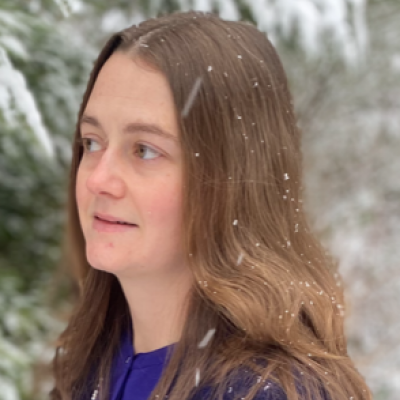
Amanda Schoolland
Metlakatla High School
Metlakatla, Alaska
Amanda Schoolland embraces the traditions of Metlakatla where she teaches. S’malgyak, the native language of the Tsimshian people who live in Metlakatla, is a dying language. “I work with members of the community and school to revive the language by using phrases in class,” Schoolland says. “In addition, we often sing songs in S’malgyak, and a local dance leader has gifted some of his original compositions to the high school band. We perform at least one of his pieces every year and use locally made hand drums decorated with Tsimshian Northwest Formline Art.”
Music is a big part of Metlakatla culture, “creating a unique history on our isolated Alaskan island,” Schoolland says. “Because of this rich background, families encourage students in any and all musical avenues. When I proposed marching in the Fourth of July and Founder’s Day parades, students were eager to give it a shot. We rehearsed through the month of June and marched in our town celebrations. This was the first marching band in decades!”
The year before Schoolland joined the faculty of Metlakatla High School as the music director, the music department was all but gone. “It has been a wonderful experience to rebuild the program and see it flourish,” she says. “Even after school hours, the band room is often filled with students excited to share their accomplishments and gain more confidence in their musical abilities. My students are gifted artists and interesting, creative individuals that make our music ensembles unique, tightly bonded and uplifting.”
Schoolland also helped revive the community choir, which used to sing Christmas carols for the holiday celebration in town. “Years prior to my move to Metlakatla saw the group perform sporadically,” she explains. “A piano player who began accompanying the school choir mentioned the community choir, and together we contacted former members and invited new singers. The first year was a small group, but consistency proved to be the key, and the next year was much larger, filled with incredible voices and camaraderie.”
In her quest to grow the music program, Schoolland lobbied school and district administrations to introduce a strings program when she saw the lack of string ensembles at the elementary and middle school levels. She then sought out grants to secure instruments through the Mr. Holland’s Opus Foundation and Colorado Public Radio, as well as through local community donations. “The first year, students participated in beginning orchestra,” she says. “By the second year, we were expanding to two and three ensembles to accommodate the number of students and various skill levels.”
In addition to music, Schoolland also teaches computer science. She keeps organized by using checklists and reminders. “For instance, I choose music selections early so I can study scores and compile sheet music for students well ahead of deadlines,” she explains. “In computer science, students are required to ask others for assistance before referring questions to me, so they are learning and teaching constantly. That leaves me more time to work with individual students on complex coding concepts. I thoroughly enjoy all the different hats I wear, which makes it easy to stay motivated.”








